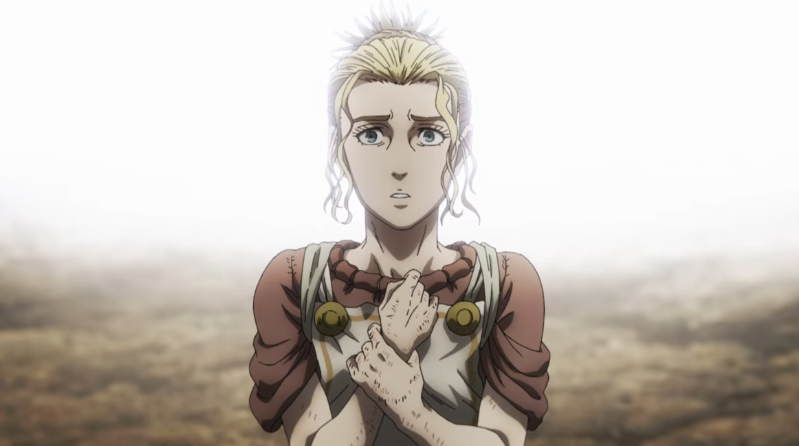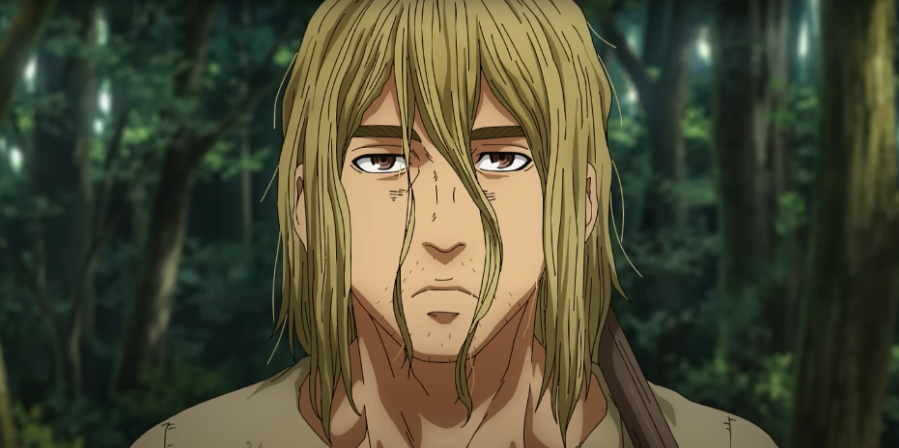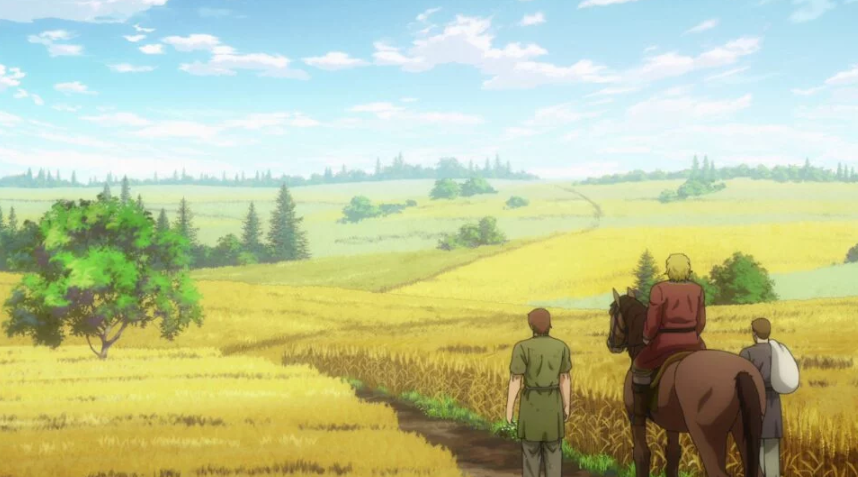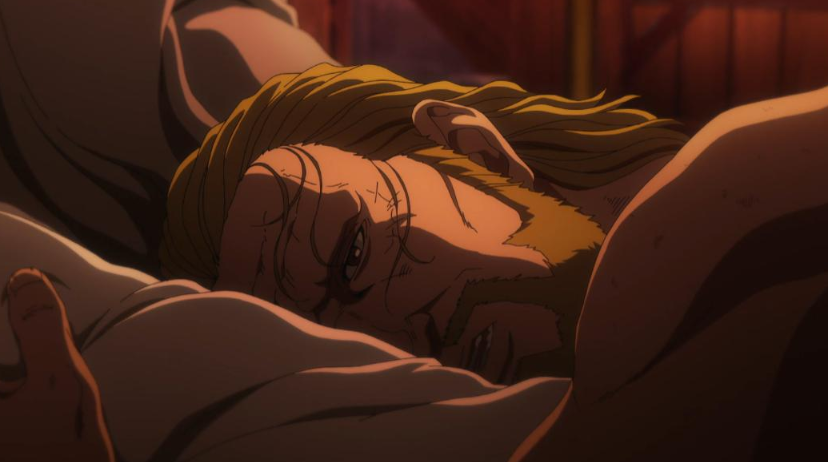Invisible Arnheid
Lately I’ve been obsessively watching anime reactions. They’re fun and mindless and pass the time between reading and writing and general life, and I like seeing how others respond to some of my favourite shows. As a popular and oft discussed series, Vinland Saga is a frequent watch among anime reactors.
Many of these reactors predictably responded ambivalently when season two first aired. For some reason, the end of season one gave the more action-hungry viewer the impression that Thorfinn would continue on a path for vengeance (against whom, exactly, when the object of his disdain is dead?), and so, seeing a broken shell of the violently angry child from season one makes them visibly uncomfortable at best, and bored at worst.
“Come on, kill something”.
I can extend grace for a little while. But it does get jarring when at certain episodes (for example, when the farm guests destroy Thorfinn and Einar’s hard work, or when Snake confronts Thorfinn and Arnheid), you can see these reactors bouncing on their chairs with excitement because now, finally, Thorfinn has to be violent and do away with all this weird depressing pacifist talk. It’s as if they’re only watching the show to see the moment when Thorfinn “breaks” and refuse to give attention to the dialogue or character journey.
The initial social media response from a lot of anime onlines made it clear that slow, deep, character studies are beyond the scope of many viewers. They want action. Kill, kill, gore, gore, and so on. As Yukimura himself says: if you want violence, go watch Attack on Titan.
But what is more disturbing to me is the response to Arnheid. Her story is the central cog in “Farmland Saga”, and the events of her life have a great impact on Thorfinn, Einar, and the entire plot of the manga as a whole. Arnheid, and Ketil, are nuanced, complex characters, but it is worrying how often viewers judge their behaviour on arbitrary, shallow indicators.
You know when someone just has too much shit??
Ketil doesn’t whip or mistreat his slaves, and decides to allow Thorfinn and Einar to “earn” their freedom “the right way”. Thorfinn and Einar are grateful because they are characters based in a world where slavery is normal and violent slave owners are common. However, as viewers, we should question why Thorfinn and Einar would need to earn something that is a human right in the first place, and why, if Ketil truly wanted to be progressive, he didn’t simply purchase people and set them free immediately afterwards.
Ketil is counter-culture enough to be lenient to his slaves, but still very much in-keeping with his time because he runs his farm on slave labour. Without slavery, Ketil would not be so rich and prosperous, and his own father condemns his avarice. Sverkel’s words are a foreshadow of the disaster to come: needless wealth-hoarding leads to needless violence. There is no need for one man to own so much. Despite all this, viewers see Ketil’s kind smile and read his words about earning back human freedoms that were wrongly stolen from Thorfinn and Einar, and happily conclude “Ketil is a good man”. On social media, this has triggered a painful discussion about the existence of “good slave owners”. What a disaster.
Pathetic
And then we get to episode seven, “Iron Fist Ketil”. Ketil struggles to punish a pair of impoverished children who stole from his farm, and is forced to beat the elder child in front of his slave hands to set an example and maintain his status as master. At the end of the episode, we see Ketil in bed with Arnheid. By this point, we already know that Arnheid is a slave, and we can make deductions about her role. At the end of this episode, Iron Fist Ketil is curled up in her lap like a child, and is tearful, because the Iron Fist moniker is a lie that he told to impress others. In reality, he is a weak, docile man and scared of his eldest son, a formidable and ruthless warrior. Arnheid is the only person Ketil trusts.
The camera pans to Arnheid’s face. She wears a blank, soulless expression. Her hands delicately rake through Ketil’s hair, but the gesture is mechanical. Arnheid is trapped. A slave-concubine. She is in a precarious and heartbreaking situation. Unlike Thorfinn and Einar, there is no offer for her to “earn back” her freedom, and in another episode, Einar expresses his concern about her future. Whereas the men have a hope, Arnheid’s life on Ketil’s farm is endless.
“The look of love”.
If red flags weren’t fluttering beforehand, episode seven should be the moment to give true pause about Ketil’s nature. Is he kindhearted and lenient? Sure. But is he a “good guy”? Would a “good guy” own slaves, hoard wealth, and keep a sex slave alongside his actual wife, whilst promising freedoms to the men who work for him? Ketil is a product of his time and location, which means he is sexist, hypocritical, and status-obsessed. Time does not make these things palatable, because in all eras, slavery has never been acceptable for the enslaved, and wherever a slave master has existed, an enslaved person has resisted. The past is swollen with the blood of rebel slaves.
But the anime reactors continue to insist that Ketil is a good guy. They cringe with him when Olmar fails to kill the pig. They share his sorrow when Canute’s plan is revealed, and they offer sympathy when he crawls from his barrel and staggers home, drunkenly calling for Arnheid, the only woman he trusts.
And what has happened to Arnheid during his time away? Her husband violently freed himself from his own bondage and found her, and she was thrown in the whirlwind of her past, and had to relive the trauma of witnessing the inevitable abduction and murder of her child, of being raped and captured and sold into slavery, of being separated from Gardar and severed from her once iydlic life. She bears witness to Gardar’s second death, and suffers beneath the weight of her past and current enslavement. When Ketil learns about this incident, he finds the cane that caused him anguish in episode seven. Beyond reason, Ketil beats Arnheid so severely that she eventually dies from her injuries.
Why are people even questioning why she would return to Gardar? Are we looking at the same man or what.
This is one of the most disturbing chapters and episodes of anything I’ve ever read. When I knew Episode 18 would contain this scene, I genuinely had to gear myself up to prepare for it, because the manga chapter had made me so angry and upset. Episode 18 is when the viewers, who up to this very point still believed Ketil to be a “good guy”, have the scales removed from their eyes. They recoil in horror and shock. They look away. Most of them wipe the whole scene from their reaction video, sickened even during the editing process. After the episode is over, they sit stunned and angry. “I thought he was a good guy” they say. “I liked him”. “Wow, he really snapped”.
Viewer, he snapped a long time ago.
Sometimes I wonder if the reason why it takes viewers so long to see Ketil the Man, and not Ketil the Good Guy, is because, like Ketil and most of the men in this story, Arnheid is invisible to them. She is not a fully-fledged person like Thorfinn and Einar. Like slavery in general, Arnheid is just a pretty archetype of her era, and so there is nothing notably disturbing about her situation. Some might even question why she is so drawn to Gardar—her literal husband—when he returns, seeing as though she has it so good on the farm. They cannot see her position as enslavement. Some reactors even ponder whether she is in love with Ketil during post-video discussions. It’s amazing to witness, especially because these views are so consistent across various reactor channels. There are others, still, who sympathise with Ketil up to him appearing in the barn, shaking their heads and muttering “man, he feels like she betrayed him”, so it can be a little satisfying to see the whiplash of horror from such reactors when he starts beating her.
PATHETIC
I think audience reactions to Arnheid are equally as upsetting as Arnheid’s story. She is the invisible slave, removed from the bargains offered to others, hidden away in Ketil’s quarters, her future denied. And the audience does not properly acknowledge her until she is getting beaten to death. Only when Ketil tips into the deep end do they see his character for what it truly is, and only during the beating do they fully understand that a slave-concubine is not an enviable position. She is trapped and without human rights. Ketil was always wrong to purchase her.
When Arnheid finally dies with Thorfinn and Einar at her side, she admits that every day felt like a nightmare. Finally, Arnheid gets to confess to the horror of her life as a slave. But Thorfinn and Einar saw her, and loved her. Their acknowledgment helped her survive. Because they saw her, Arnheid’s days were better. With this story, Yukimura has created characters that demand to be acknowledged. Vinland Saga is so much more than mindless violence and vengeance. It is about one man’s journey to create a world where the invisible are seen.






